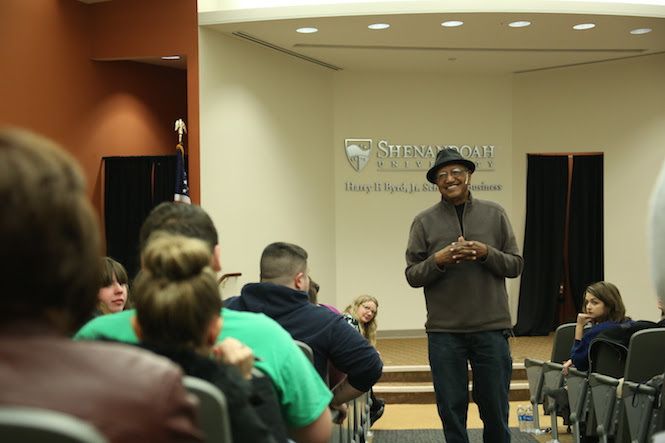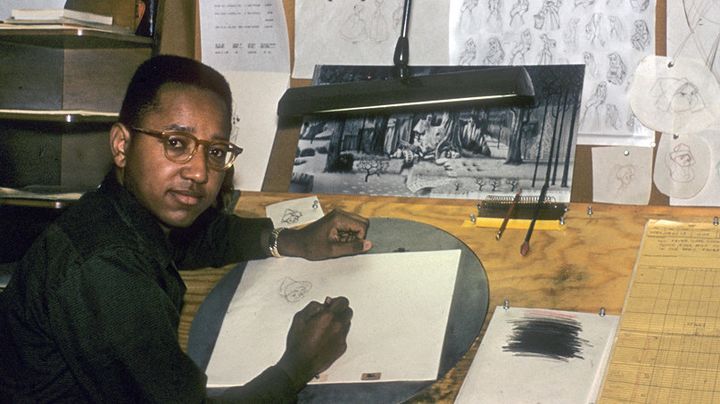
(PHOTO: Scott Spriggs)
Former Animator of the Walt Disney Company tells his story at Shenandoah University
Shenandoah University’s School of Business hosted the celebrated Disney animator on February 1st, kicking off their Black History Month celebration. Floyd Norman was the first African-American animator hired at the Walt Disney Company in 1956. Being an inexperienced 18 year old, Norman said he was “ a young man eager to make a start in the entertainment business.” After a long and successful career, the now 81 year old shared his anecdotes of working with Walt Disney himself, and discussed, using his encyclopedic memory, the intricacies of classic Disney films ranging from Sleeping Beauty to Toy Story 2. When broadly asked “What films did you work on?” he chuckled and replied “Too many too tell.”
The long-time animator described his first time walking onto the Walt Disney Studios Lot in Burbank, CA as “walking into wonderland: a magic factory.” The animation business was not as prestigious in the 60’s as it is now, he modestly said that he had a lot easier time than some of his current students trying to pursue a career in the entertainment industry. “Very few people were crazy enough to be in the animation business [back then]”
One of his anecdotes shared was when Walt Disney called all of the animators to a meeting in 1960 and told them his plans for the future: his magnificent plan was to create an entire city in Orlando, Florida. A “city of tomorrow” that would be safe, clean, and comfortable for all who lived there. This city, which we now know to be the early plans for Disney World, was unfortunately not completed before Walt died in 1966.

Floyd Norman working on Sleeping Beauty in 1956.
Wearing a dark brown fedora, a quarter zip sweater, and jeans, Norman spoke with ease as his voice glazed over decades of Disney history, the audience hypnotized. Floyd claims to have gone into the entertainment business not for the fame or fortune, but to entertain people. “If I could make children laugh and adults smile, then I did my job.”
The classic film Sleeping Beauty took six years to complete, compiled of thousands of drawings with every frame painted by hand. He had a euphoric and sentimental look on his face when he described working on the “Once Upon A Dream” sequence in the movie with Briar Rose, while playing a clip from the film. He explained how there was an assigned artist that would draw a singular character throughout the film, always mentioning his former colleagues’ names when Briar Rose or the Prince would appear on screen. 101 Dalmatians was a refreshing stylistic change for the animator, as it was a departure from the European fairy-tales Disney had been producing, being a more contemporary story. He mentioned how it was one of his favorite films he worked on throughout his career, touching upon how much he adored the antagonist Cruella de Vil.
“What we did in 1997 for Toy Story 2 looked crummy in 1998 because the technology advanced.” Floyd Norman
Floyd spoke a lot of how his career was always entangled with the advancement of technology. With Beauty and the Beast being Disney’s first fully digitalized animation, the company continually took steps forward in the technological quality of their work. While working on Toy Story 2, the level of computer animation had drastically improved in one year of production that the sequences created six months previous had to be redone because they looked ‘crummy’. Norman claimed that out of all the works he collaborated on, he is most proud of Toy Story 2.
There were many questions from the audience regarding Floyd’s relationship with Walt Disney, as he is such an iconic and influential figure within the realm of entertainment, and well...MAGIC. “He was just an ordinary kind of guy. He was one of us and that was his appeal. That’s why his stories resonate. He knows how we feel.” The animator spoke of Mr. Disney with such fiery respect and admiration, fixating on how Walt was just a regular guy who knew how to connect with an audience. Walt viewed his audiences as intelligent viewers, Norman claimed that Disney would scold the production team if they had ‘dumbed down’ material for children, reminding the creators that children were smarter than given credit for. Walt Disney was a pure example of the American dream: having been a young boy from the midwest who traveled to California to create a new life, but what he didn’t know was the legacy he would leave behind for years to come.
“Animation can explain whatever the mind of man can conceive.” Walt Disney
As the Dean of the Business School: Miles Davis introduced the guest speaker at the beginning of the lecture, he reminded the audience how it is rare to come in contact with a living historical figure, and Mr. Norman is just that. He lived through and contributed to the classic films millions of people around the globe hold dear: Sleeping Beauty, 101 Dalmatians, The Jungle Book, Robin Hood, Toy Story 2, even Scooby Doo.
When asked what advice should he give to the artists of the future he said “One of the most important things I’ve learned is to LEARN EVERYTHING. Study art, study music, study dance, study astronomy. Everything you learn informs you and makes you a better storyteller. You learn by doing and doing until you get good at it, and then you’re still learning.”
